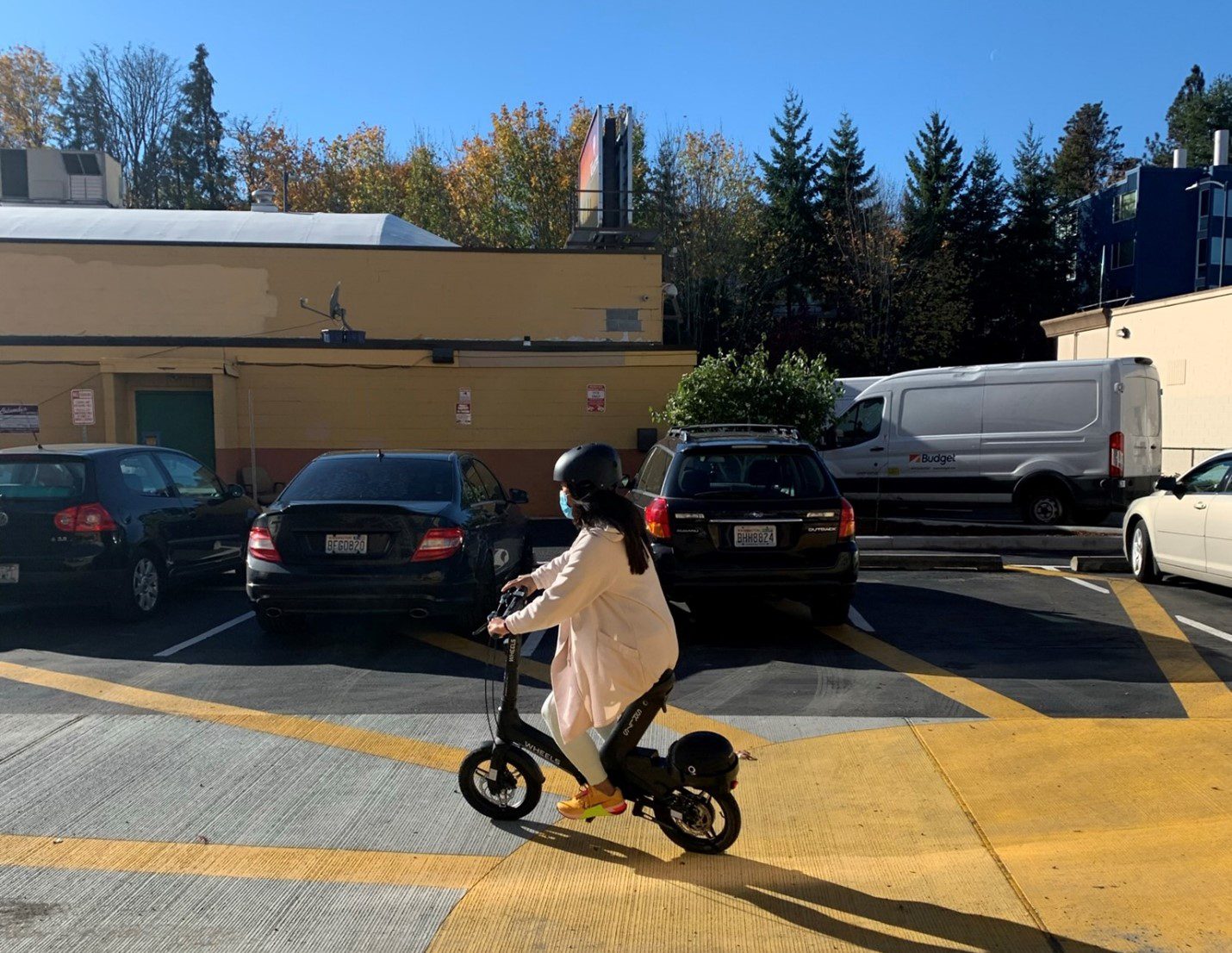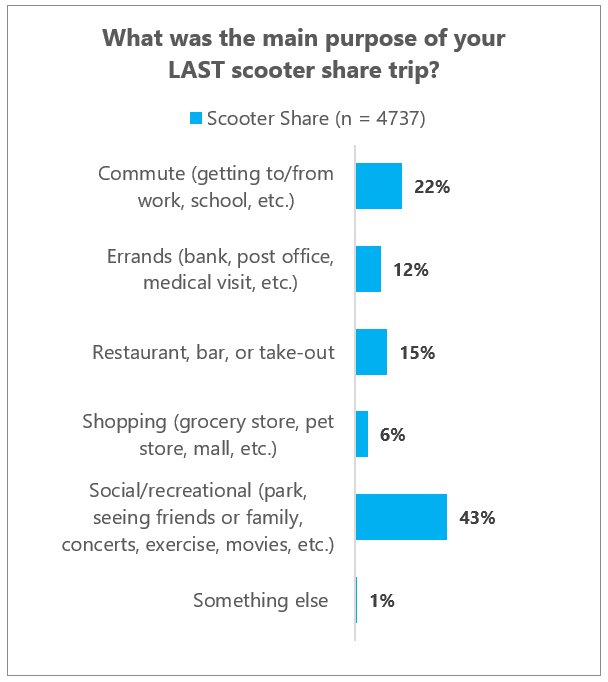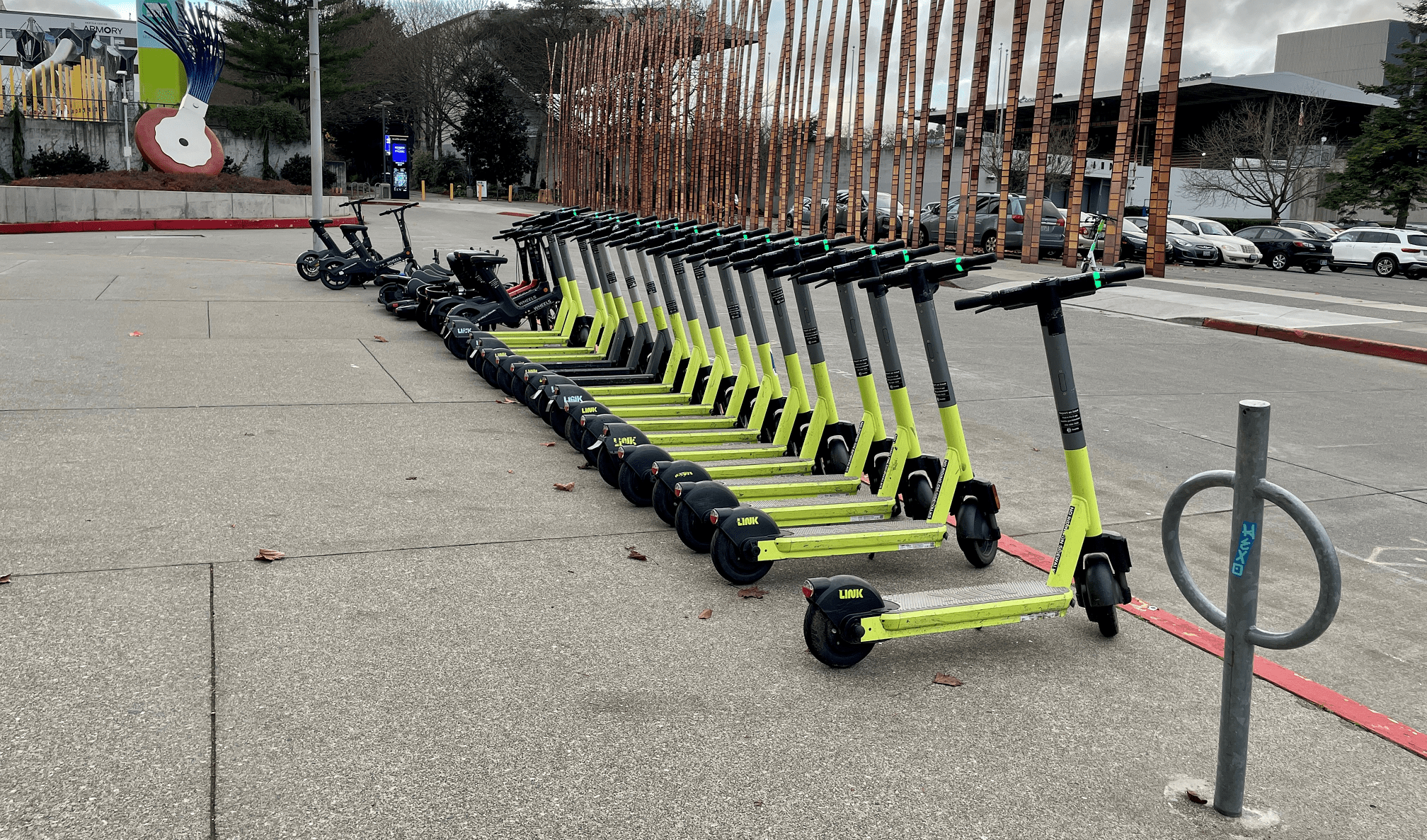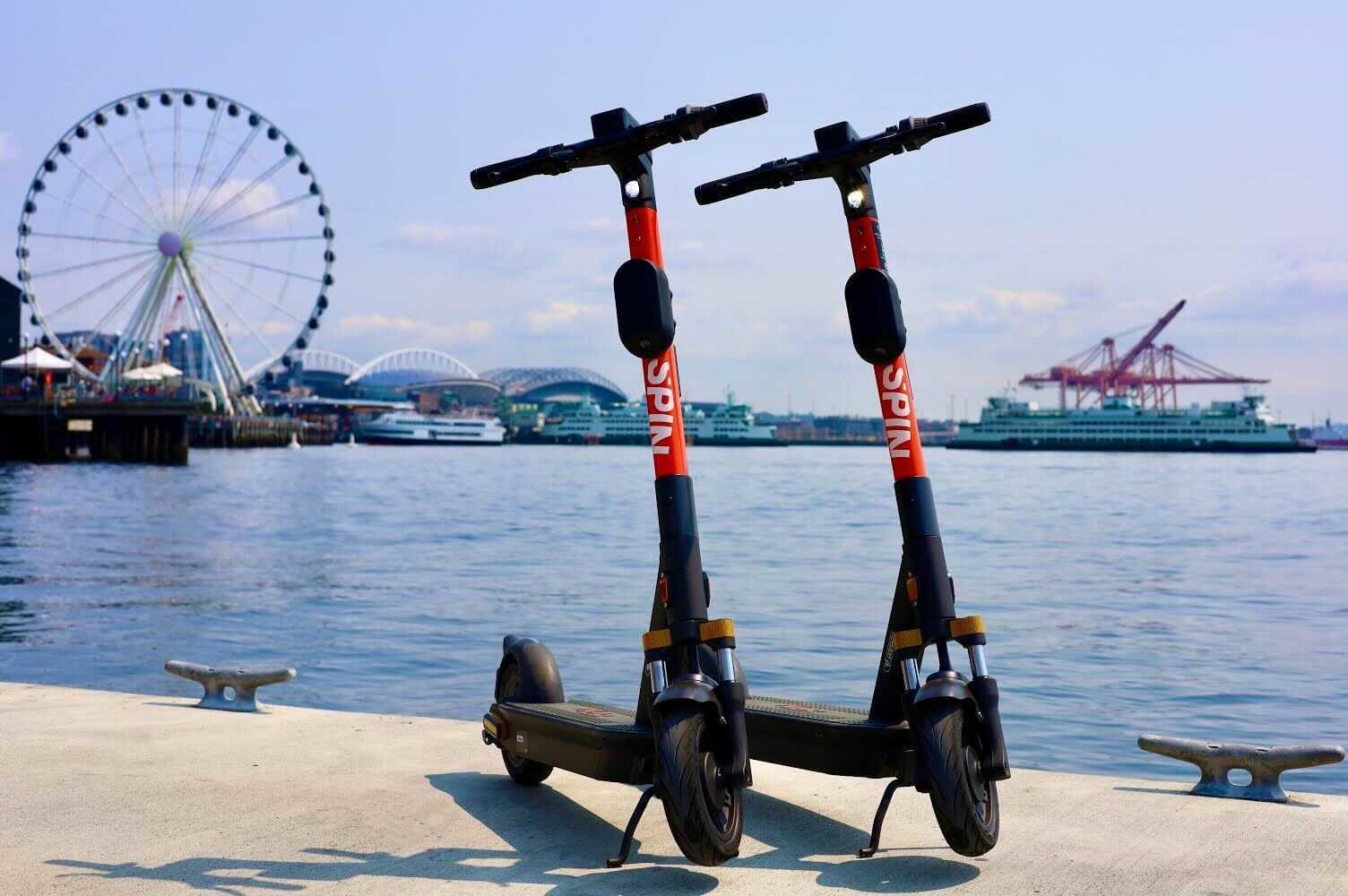 A person practices riding a scooter at a scooter outreach event held in October 2021. Photo: SDOT
A person practices riding a scooter at a scooter outreach event held in October 2021. Photo: SDOT Summary:
- There is demand for scooter share and scooters provide a flexible, low-emissions travel option.
- During our scooter share pilot program, 260,000 riders took over 1.4 million trips between October 2020 and September 2021.
- 21% of riders surveyed said they connected to transit, and over half said they would have used a taxi, ride-hail, or personal vehicle if scooter share had not been available.
- Safety remains a top priority. During the pilot program, 17 crashes were recorded through police reports, and 12% of riders self-reported various injuries through an online survey.
- Scooter parking improved during the pilot program, with documented obstructions of sidewalks and paths dropping from 21% to 8%. This continues to be an important focus as we move toward our goal of 3% or lower of total program scooters resulting in obstructions.
- Continue to proactively work on designated parking zones in high destination locations and implement user operator fines as needed to reduce pedestrian obstructions.
- Next, we’ll launch a competitive permit selection process and require future operators to develop and implement plans to discourage scooter riding on and obstructing sidewalks and paths; and implementing best practices from other cities.
- Continue to expand the citywide bike network, which scooter riders can use.
We recently finalized a 2020-2021 Scooter Share Pilot Program Evaluation Report, now available on our website. The scooter share program gives Seattle residents and visitors a new, low-emission transportation option to get to a variety of desired destinations.
Pilot Program at-a-glance:
- Scooter operators to date have included: Lime, Link, Wheels, and Spin.
- People took over 1.4 million trips from October 2020 through September 2021.
- An average of 2,600 scooters were available in Seattle on any given day. The number grew steadily over time, reaching a peak of roughly 5,100 scooters in September 2021.
- The most popular trip destinations are within the Center City, with additional concentrated areas around the University District, Fremont, Ballard, and Alki Beach.
- The most common reason people use scooters (and bike share) was for social or recreational purposes (43%).
We’ve summarized our key findings and areas for future improvement below.
Perceptions of safety and injury statistics
Our scooter pilot program report includes data from police reports, as well as self-reported injury data. This information helps us better understand if and how riders of shared scooters were injured. We will continue to assess data needs and consider other opportunities for information gathering and decision-making in coordination with our Vision Zero, Bicycle, and Pedestrian programs.
- We conducted a bike and scooter share rider survey in the fall of 2021. We received more than 5,000 responses from people who had used scooter share.
- The survey evaluated who uses scooters in Seattle, why, and when. We also asked people to tell us if they had been hurt while riding a scooter. Some multiple choice questions have answers adding up to more than 100% because respondents were able to choose more than one answer.
- The survey has the added benefit of capturing input from those that did not require or seek medical care. Approximately 11% of total respondents reported experiencing an injury. 2.3% of total respondents sought medical attention, and 8% reported an injury but said they did not seek medical attention for their injury. Some people reported being injured but did not say whether or not they sought medical attention.
- The reasons for reported injuries included not being aware of changes in the right-of-way, like raised pavement, potholes, or debris. Some noted driver inattentiveness and being struck or needing to veer away from those driving too close.
- We also reviewed over 8,000 police reports covering a wide range of incidents, and found 17 instances in which a scooter rider was involved. In many cases, we could not verify if the scooter was privately owned or part of the scooter share pilot program.
Fall 2021 survey responses regarding scooter share trip purposes (about 4,700 people answered this question, out of over 5,000 survey participants).

Keeping sidewalks clear
- Scooters parked and not in use can become obstructions on sidewalks for people walking and rolling through the city. We conduct weekly audits of parked scooters. Our target is 3% or less of total scooter share scooters in circulation are obstructions. We have seen improvement, but we’re not there. Our first quarter of audits in Q4 2020 showed 21% of devices as obstructions, and by Q3 2021, the number was had decreased to 8%.
- While riding scooter share scooters on the sidewalk is not allowed, many scooter riders continue to take portions of trips on the sidewalk – which may cause people walking or rolling to feel unsafe.
- Our survey found that 22% of people made some trips on the sidewalk. 78% rode in a bike lane, in a shared-use path, or in the street, where scooter riding is allowed. Factors such as crowding and volume of other travelers contributed to where people feel the safest to ride. If many people were using the sidewalk, rides were typically made in the street. If there were a lot vehicles in the street, scooter riders sometimes chose the sidewalk. Through our Vision Zero Program, speed limits on most major streets are 25 mph and residential streets are 20 mph. We also continue to build a citywide bike network for people of all ages and abilities. These actions improve safety for everyone and encourage scooter riders to stay off the sidewalk.

Who is using scooter share
- A wide range of people used scooter share during the pilot program. However, we want to improve access for all community members, including people from a wide range of cultures, ages, abilities, and levels of comfort. This is an important goal to ensure our program is safe, accessible, and open to all Seattleites, in line with our One Seattle approach to inclusion.
- Potential barriers to participation include a need for more translated information and support, clearer guidance and resources about how to sign up for reduced-fare plans, and more hands-on support for using the scooters and associated apps.
Did you know? Scooter share fees help fund an adaptive cycling program in Seattle – the largest of its kind in the country! A partnership with the Outdoors for All Foundation
We also use permit fees to support a unique program that creates an opportunity for people with disabilities to enjoy cycling using adaptive cycles for free at Seattle’s Magnuson Park and events in various locations during the summer months. The program has been a success, thanks largely to this funding and our close partnership with Outdoors for All. Check out our September 2021 blog post about the program. We plan to continue the program in the summer of 2022, with funds provided by City Council this year – stay tuned for details coming soon.

What’s next: we are opening a competitive permit application process for up to 4 scooter share operators
Next, we will launch a competitive application process for scooter share in Seattle. This could include companies operating today, as well as new ones. The process will focus on addressing challenges identified during through the evaluation.
- Include a permit application requirement that each operator provide a plan to help decrease sidewalk riding and describe how they will continue working to reduce sidewalk obstructions through technology solutions and educational efforts.
- Permits will continue to include operator fines of $20 for every device found to be an obstruction, and they may pass the fine on to the last rider who parked. In addition, vendors may face fines of $500 or more, or face alternative sanctions such as reduced fleet sizes, for violating other parts of the permit requirements.
- Build on what we learned at Alki Beach using GPS technology requiring riders to park in designated spots, at destinations like Pike Place Market where a higher number of obstructions are observed. These efforts supplement the 3,000 bike and scooter parking spaces installed over the past 5 years and are combined with requests for operators to sweep these areas on a regular cadence to reset scooter locations.
- Use customer feedback and data to make scooters available and grow ridership in equity focus areas.
- Increase staff levels to expand outreach to neighborhoods with low use by providing riding demonstrations at existing events, improving access to our reduced fare program, and distributing helmets. We will consider expanding incentive programs like West Seattle Flip Your Trip program into other neighborhoods.
In conclusion
We look forward to working with operators and the Seattle community to advance a scooter share program that enhances sustainability, safety, and is built on strong community engagement and participation. Thank you!